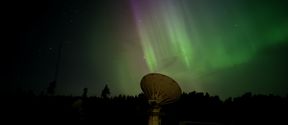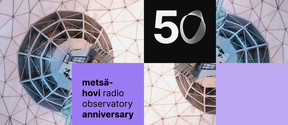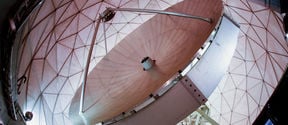Metsähovi Radio Observatory turns 50 and gets new telescopes
Students helped design and build the new telescopes, which expands the opportunities for multidisciplinary space research and education

At the end of a winding country road is a fenced area which you can’t enter unless you turn off your phone, data, wireless, and Bluetooth from your devices – it’s full radio silence.
The Metsähovi Radio Observatory in Kirkkonummi is the only one of its kind in Finland, with its researchers often working with colleagues around the world on major international space projects. The landmark feature of the radio observatory is a giant golf ball-shaped dome that conceals Metsähovi’s crown jewel, a 14-metre radio telescope that’s been dutifully observing space for half a century.
The research at Metsähovi focuses mainly on millimetre and microwave radiation from the Sun, variable quasars – the active nuclei of distant galaxies – and very-long-baseline interferometry (VLBI).
With VLBI, radio telescopes around the world act as a single, globe-sized telescope. This is the technique behind the very first images of a black hole, which Metsähovi helped produce.
In the coming years, Metsähovi will undergo many changes, including the installation of a new receiver for the 14-metre radio telescope next year. The receiver is the heart of the telescope, so this state-of-the-art device will revolutionise the way Metsähovi makes observations and enable new types of research, both as part of international networks and on its own.
Recently, smaller, 5.5-metre telescopic booms have started to rise in the Metsähovi yard. The MCA, or Metsähovi Compact Array, is a set of radio telescopes that has involved students from different disciplines in its design and construction. The project is unique in its multidisciplinary approach and practical teaching, and similar examples are hard to find in Europe.
Jere Raassina, a student of space science and technology at Aalto University, programmed the control software for the individual telescopes used in the MCA project. With Raassina’s software, a set of multiple antennas can be controlled to perform measurements automatically or be given individual commands, such as pointing the antenna at a specific target or turning on data recording.
The best thing about the project for Raassina was that he was able to use his own expertise in a concrete way. ‘The moments that stand out in my mind are when I got something new to work. For example, when I could move the antennas on my laptop or when I saw the data from the first measurements,’ he says.
Smaller telescopes can also use interferometry technology, meaning they can be combined to form one giant telescope. Two of the four radio telescopes in the MCA project are already operational.
‘Once the radio telescopes are connected and more telescopes are completed, a whole new world of research opportunities will open. Even before that, the equipment will be in active use, with students from different disciplines involved in its construction and development, who will be able to work with the radio telescopes,’ says Director of Metsähovi Joni Tammi.

Metsähovi is actively working to ensure that Finland has enough space scientists and astronomers for the future. The MCA telescopes have opened up more opportunities for cooperation with schools.
Joni Tammi’s own career choice was greatly influenced by meeting space scientists as a teenager. He wants to encourage young people to enter the field by telling them about research and the work of a scientist. Their enthusiasm also reminds him of what drove him into the field in the first place.
‘In the midst of funding applications and quality assurance projects, you need occasional reminders that you get to be one of the first to hear about or discover extremely interesting things,’ says Tammi.
One of these enthusiastic young people is Anna Casella, a ninth-grader at Jokirinne School, who completed her TET period of work experience at Metsähovi.

Casella, who lives in Kirkkonummi, has been interested in space since primary school, but until her school and Metsähovi collaborated, she had no idea that her hometown had the only radio observatory in the country.
Casella’s internship allowed her to learn about the observatory, demonstrate remote observing at a technology event for high school students, and help build a 3D model of the telescope. The model will be on display at Aalto University’s Designs for a Cooler Planet exhibition in the autumn.
‘I already had the idea that I wanted to study something related to space or technology. The internship confirmed that this is what I like,’ says Casella.
And what has it been like to spend your days in radio silence without a phone?
‘It hasn’t been difficult at all! It’s been wonderful.’
Joni Tammi, Director of MetsähoviYou get to be one of the first to hear about or discover extremely interesting things.

This article has bee published in the Aalto University Magazine issue 34 (issuu.com) September 2024.

Students helped design and build the new telescopes, which expands the opportunities for multidisciplinary space research and education

The open lecture series will cover the study of restless black holes, Earth-sized telescopes and what the historic 50-year history of solar research can tell us about ourselves and our future on Earth. The lecture series is open to all and will take place online and in person in Otaniemi in autumn 2024. The event series is held mainly in Finnish. Welcome!

Metsähovi Radio Observatory is the only astronomical radio observatory in Finland. Metsähovi’s main instrument is the 14-metre radio telescope, which is used around the clock, every day of the year. Its observational data is used, e.g., for studying active galaxies, the Sun, and the rotation of the Earth.



